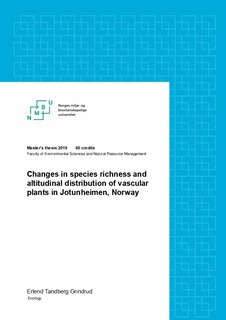| dc.contributor.advisor | Klanderud, Kari | |
| dc.contributor.advisor | Grytnes, John-Arvid | |
| dc.contributor.author | Grindrud, Erlend Tandberg | |
| dc.coverage.spatial | Norway, Jotunheimen | nb_NO |
| dc.date.accessioned | 2019-07-17T10:07:15Z | |
| dc.date.available | 2019-07-17T10:07:15Z | |
| dc.date.issued | 2019 | |
| dc.identifier.uri | http://hdl.handle.net/11250/2605634 | |
| dc.description.abstract | Species richness was sampled on 254 sites distributed along the altitudinal gradient of 23 mountains in Jotunheimen, Norway. The sampling was conducted during the summer of 2014, on sites that previously had been sampled in 1930-31 and 1998. The purpose of the study was to investigate possible changes in species richness and altitudinal distribution of vascular plants, and try to explain any observed change.
The results show that species richness in Jotunheimen increased between 1998 and 2014, and that the relative increase was highest at higher elevation sites. Species richness also increased more in eastern parts of Jotunheimen than in western parts, both in 1930/31-1998 and 1998-2014. Species richness on the most species-rich sites has declined in 1998-2014, and high-altitude species have possibly declined at lower elevations. The high-altitude species Beckwithia glacialis, Ranunculus pygmeus, Poa flexuosa, Saxifraga Cernua and Erigeron uniflorus experienced a reduced number of occurrences at lower elevations in 1930/31-1998, and has continued this tendency in 1998-2014. High-altitude species that did not decline at lower elevations in 1930/31-1998 (e.g. Cardamine bellidifolia, Luzula confusa and Juncus biglumis) have started to decline in 1998-2014. A process called thermophilization, which can be described as the decline of cold-adapted species and/or the increase of higher temperature-adapted species, was detected for both 1930/31-1998 and 1998-2014 in Jotunheimen. Plant communities have hence become “warmer”.
A strong warming tendency is observed after the 1998 sampling, and climate warming is the most likely driver of the observed changes in Jotunheimen. Nitrogen deposition and grazing pressure have been discussed, but further investigation is needed to determine their role. Hiking tourism, pseudoturnover and natural succession, are found to not explain the general changes observed in this study. | nb_NO |
| dc.language.iso | eng | nb_NO |
| dc.publisher | Norwegian University of Life Sciences, Ås | nb_NO |
| dc.rights | Attribution-NonCommercial-NoDerivatives 4.0 Internasjonal | * |
| dc.rights.uri | http://creativecommons.org/licenses/by-nc-nd/4.0/deed.no | * |
| dc.subject | Jotunheimen | nb_NO |
| dc.subject | Norway | nb_NO |
| dc.subject | Norge | nb_NO |
| dc.subject | Climate change | nb_NO |
| dc.subject | Plant ecology | nb_NO |
| dc.subject | Alpine plants | nb_NO |
| dc.subject | Alpine species | nb_NO |
| dc.subject | Thermophilization | nb_NO |
| dc.subject | Høyfjellsplanter | nb_NO |
| dc.subject | Økologi | nb_NO |
| dc.subject | Klimaendringer | nb_NO |
| dc.title | Changes in species richness and altitudinal distribution of vascular plants in Jotunheimen, Norway | nb_NO |
| dc.type | Master thesis | nb_NO |
| dc.description.version | submittedVersion | nb_NO |
| dc.subject.nsi | VDP::Matematikk og Naturvitenskap: 400::Zoologiske og botaniske fag: 480::Økologi: 488 | nb_NO |
| dc.subject.nsi | VDP::Matematikk og Naturvitenskap: 400::Zoologiske og botaniske fag: 480::Systematisk botanikk: 493 | nb_NO |
| dc.source.pagenumber | 114 | nb_NO |
| dc.description.localcode | M-ECOL | nb_NO |

